东南大学学术论文写作单元Unit
- 格式:ppt
- 大小:221.50 KB
- 文档页数:44
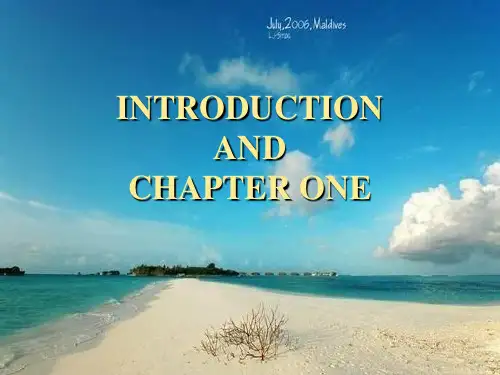


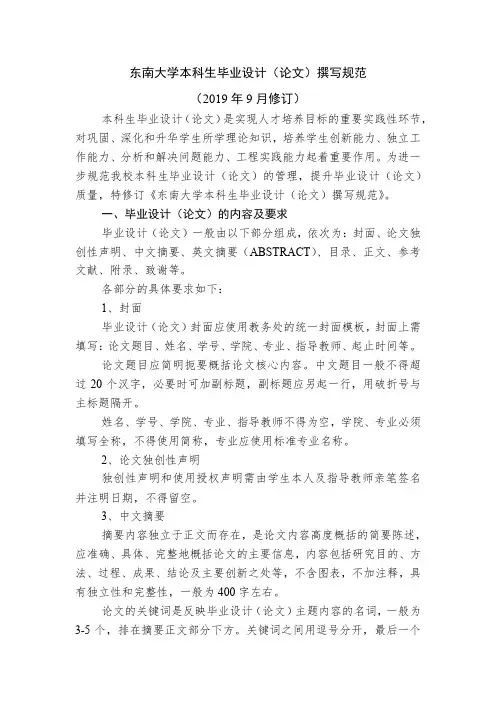
东南大学本科生毕业设计(论文)撰写规范(2019年9月修订)本科生毕业设计(论文)是实现人才培养目标的重要实践性环节,对巩固、深化和升华学生所学理论知识,培养学生创新能力、独立工作能力、分析和解决问题能力、工程实践能力起着重要作用。
为进一步规范我校本科生毕业设计(论文)的管理,提升毕业设计(论文)质量,特修订《东南大学本科生毕业设计(论文)撰写规范》。
一、毕业设计(论文)的内容及要求毕业设计(论文)一般由以下部分组成,依次为:封面、论文独创性声明、中文摘要、英文摘要(ABSTRACT)、目录、正文、参考文献、附录、致谢等。
各部分的具体要求如下:1、封面毕业设计(论文)封面应使用教务处的统一封面模板,封面上需填写:论文题目、姓名、学号、学院、专业、指导教师、起止时间等。
论文题目应简明扼要概括论文核心内容。
中文题目一般不得超过20个汉字,必要时可加副标题,副标题应另起一行,用破折号与主标题隔开。
姓名、学号、学院、专业、指导教师不得为空,学院、专业必须填写全称,不得使用简称,专业应使用标准专业名称。
2、论文独创性声明独创性声明和使用授权声明需由学生本人及指导教师亲笔签名并注明日期,不得留空。
3、中文摘要摘要内容独立于正文而存在,是论文内容高度概括的简要陈述,应准确、具体、完整地概括论文的主要信息,内容包括研究目的、方法、过程、成果、结论及主要创新之处等,不含图表,不加注释,具有独立性和完整性,一般为400字左右。
论文的关键词是反映毕业设计(论文)主题内容的名词,一般为3-5个,排在摘要正文部分下方。
关键词之间用逗号分开,最后一个关键词后不加标点符号。
4、英文摘要英文摘要应与中文摘相对应,250个实词左右。
采用第三人称(被动语态)介绍该学位论文内容,叙述的基本时态为一般现在时,确实需要强调过去的事情或者已经完成的行为才使用过去时、完成时等其他时态。
5、目录论文目录是论文的提纲,也是论文各章节组成部分的小标题。
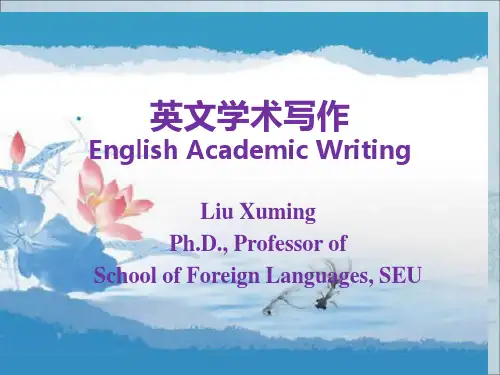
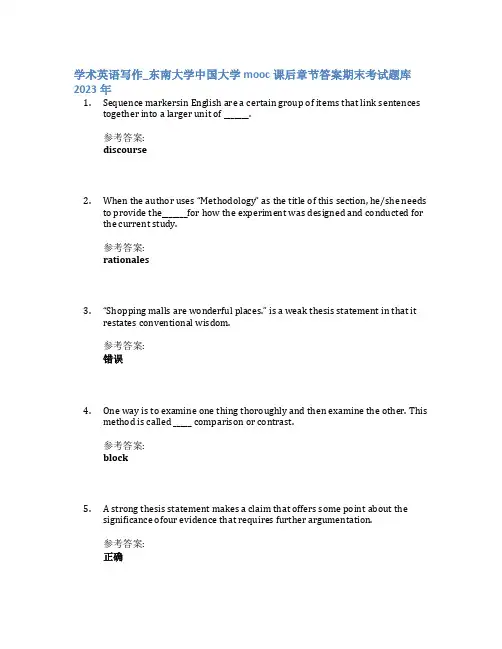
学术英语写作_东南大学中国大学mooc课后章节答案期末考试题库2023年1.Sequence markersin English are a certain group of items that link sentencestogether into a larger unit of _______.参考答案:discourse2.When the author uses “Methodology” as the title of this section, he/she needsto provide the_______for how the experiment was designed and conducted for the current study.参考答案:rationales3.“Shopping malls are wonderful places.” is a weak thesis statemen t in that itrestates conventional wisdom.参考答案:错误4.One way is to examine one thing thoroughly and then examine the other. Thismethod is called _____ comparison or contrast.参考答案:block5. A strong thesis statement makes a claim that offers some point about thesignificance ofour evidence that requires further argumentation.参考答案:正确6.Strictly speaking, the purpose of _______ is to show similarities while contrastis used to show differences.参考答案:comparison7.In the elements of the Method Section, ______ refer to the precautions taken tomake sure that the data are valid.参考答案:Restrictions8.Paraphrasing is to explain the original ideas of a passage, chapter, article orbook in fewer words.参考答案:错误9.To avoid plagiarism and conform to academic ethics, you need to providereference to every citation and check for plagiarism before submitting your paper.参考答案:正确10.Which of the following tenses could be used to discuss previously publishedworks which is generally considered to be established knowledge?参考答案:The present simple11.Which of the following tenses could be used when the year of publication isstated within the main sentence.参考答案:The past tense12.Which of the following reporting verbs could be categorized as strong?参考答案:reject13.Reporting verbs can indicate either参考答案:All of the options.14.What is included in a complex model of literature review but NOT included ina simple one?参考答案:Research question15.You can choose any information or data from the graphwhen you describeagraph.参考答案:错误16.Redundancy, raising a totally new point, understatement, anticlimax are thetypical issues in structuring the Conclusion.参考答案:错误17.Unlike the Abstract and Introduction,the Conclusions section does providebackground details.参考答案:错误18. 1. The register of the following discourse is____.I, James Bond, take you, JudithKroll, to be my wife, to have and to hold from this day forward, for better, for worse, for richer, for poorer, in sickness and in health, to love and to cherish, till death us do part, according to God's holy law, in the presence of God Imake thisvow.参考答案:static19.What should you do when you write a literature review?参考答案:Include a critical analysis of various opinions from credible sources.20.To end the Discussion section which also has a Conclusion, the author mayadmit what she/he has not been able to do and as a consequence cannotprovide conclusions on.参考答案:正确21.If the authors are to announce the results of their study, they can just statethe results without saying “we think that…”参考答案:正确22.You can use “he or she” to avoid gender discrimination every time when youmean “everyone”.参考答案:错误23.When writing an academic paper, you should nominalize as many words aspossible.参考答案:错误24.Beginning the Discussion section an author would possibly refer back topapers he/she cited in the Review of the Literature.参考答案:正确25.“The U.S. constitution” is not a good title for an essay, because it is toogeneral.参考答案:正确26.“What implications are revealed in my results?” is a question to considerafter drafting the Discussion section.参考答案:错误27.The process paragraphs are usually developed step by step in a chronologicalor logical sequence.参考答案:正确28.The Results Section can only be presented both in diagrams or graphs.参考答案:错误29.The Method Section can be called Materials and Methods in naturalsciences.参考答案:正确30.The Method Section is considered the most important section becauseitappears in the middle of a research paper.参考答案:错误31.Nominalization is the process of converting simple nouns within a sentenceto complex nouns.参考答案:错误32.If you can discuss a cause without having to discuss any other causes thenvery likely it is an indirect cause.参考答案:错误33.Oversimplification should be avoided because many problems have complexcauses and complex effects.参考答案:正确34.First personal pronouns can never be used in academic paper.参考答案:错误35. A weak thesis statement either makes no claim or makes a claim that doesnot need proving.参考答案:正确36.One of the key elements of the Conclusion section is a final judgment on theimportance and significance of the findings in terms of their implications and impact, along with possible applications to other areas.参考答案:正确37.Effects are the consequences of an event and they respond to the question“Why did that event happen?”参考答案:错误。




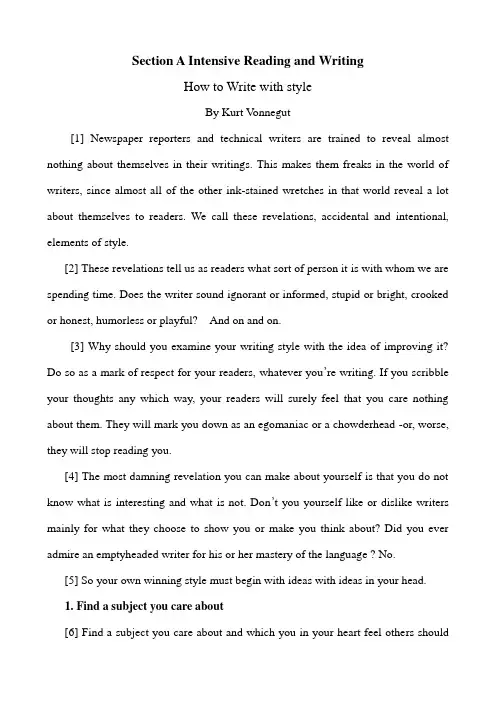
Section A Intensive Reading and WritingHow to Write with styleBy Kurt V onnegut[1] Newspaper reporters and technical writers are trained to reveal almost nothing about themselves in their writings. This makes them freaks in the world of writers, since almost all of the other ink-stained wretches in that world reveal a lot about themselves to readers. We call these revelations, accidental and intentional, elements of style.[2] These revelations tell us as readers what sort of person it is with whom we are spending time. Does the writer sound ignorant or informed, stupid or bright, crooked or honest, humorless or playful? And on and on.[3] Why should you examine your writing style with the idea of improving it? Do so as a mark of respect for your readers, whatever you’re writing. If you scribble your thoughts any which way, your readers will surely feel that you care nothing about them. They will mark you down as an egomaniac or a chowderhead -or, worse, they will stop reading you.[4] The most damning revelation you can make about yourself is that you do not know what is interesting and what is not. Don’t you yourself like or dislike writers mainly for what they choose to show you or make you think about? Did you ever admire an emptyheaded writer for his or her mastery of the language ? No.[5] So your own winning style must begin with ideas with ideas in your head.1. Find a subject you care about[6] Find a subject you care about and which you in your heart feel others shouldcare about. It is this genuine caring, and not your games with language , which will be the most compelling and seductive element in your style.[7] I am not urging you to write an novel, by the way – although I would not be sorry if you wrote one, provided you genuinely cared about something. A petition to the mayor about a pothole in front of your house or a love letter to the girl next door will do.2. Do not ramble, though[8] I won’t ramble on about that.3. Keep it simple[9] As for your use of language: Remember that two great masters of language, William Shakespeare and James Joyce, wrote sentences which were almost childlike when their subjects were most profound. ―To be or not to be?‖ asks Shakespeare’s Hamlt. The longest word is three letters long. Joyce, when he was frisky, could put together a sentence as intricate and as glittering as a necklace for Cleopatra, but my favorite sentence in his short story , ―Evelin‖is this one: ―She was tried.‖At that point in the story, no other words could break the heart of a reader as those three words do.[10] Simplicity of language is not only reputable, but perhaps even sacred. The Bible opens with a sentence well within the writing skills of a lively fourteen-year-old: ―In the beginning God created the neaven and the earth.‖4. Have guts to cut[11] It may be that you, too, are capable of making necklaces for Cleopatra, so to speak. But your eloquence should be the servant of the ideas in your head. Your rulemight be this: If a sentence, no matter how excellent, does not illuminate your subject in some new and useful way, scratch it out.5. Sound like yourself[12] The writing style which is most natural for you is bound to echo the speech you heard when a child. English was Conrad’s third language , and much that seems piquant in his use of English was no doubt colored by his first language, which was Polish. And lucky indeed is the writer who has grown up in Ireland, for the English spoken there is so amusing and musical. I myself grew up in Indianapolis, where common speech sounds like a band saw cutting galvanized tin, and employs a vocabulary as unornamental as a monkey wrench.[13] In some of the more remote hollows of Appalachia, children still grow up hearing songs and locutions of Elizabethan times. Yes, and many Americans grow up hearing a language other than English, or an English dialect a majority of Americans cannot understand.[14] All these varieties of speech are beautiful , just as the varieties of butterflies are beautiful, No matter what your first language, you should treasure it all your life, If it happens to not be standard English, and if it shows itself when you write standard English, the result is usually delightful, like a very pretty girl with one eye that is green and one that is blue.[15] I myself find that I trust my own writing most, and others seem to trust it most , too, when I sound most like a person from Indianapolis, which is what I am. What alternatives do I have? The one most vehemently recommended by teachers has no doubt been pressed on you, as well: to write like cultivated Englishmen of acentury or more ago.6. Say what you mean[16] I used to be exasperated by exasperated by such teachers, but am no more, I understand now that all those antique essays and stories with which I was to compare my own work were not magnificent for their datedness or foreignness, but for saying precisely what their authors meant them to say. My teachers wished me to write accurately, always selecting the most effective words, and relating the words to one another unambiguously, rigidly, like parts of a machine. The teachers did not want to turn me into an Englishman after all. They hoped that I would become understandable—and therefore understood. And there went my dream of doing with words what words what Pablo Picasso did with paint or what any number of jazz idols did with music. If I broke all the rules of punctuation, has words mean whatever I wanted them to mean, and strung them together higgledy- piggledy, I would simply not be understood. So you , too, had better avoid Picasso-style writing, if you have something worth saying and wish to be understood.[17] Readers want our pages to look very muck like pages they have seen before. Why? This is because they themselves have a tough job to do, and they need all the help they can get from us.7. Pity the readers[18] They have to identify thousands of little marks on paper, and make sense of them immediately. They have to read, an art so difficult that most people don’t really master it even after having studied it all through grade school and high school–twelve long years.[19] So this discussion must finally acknowledge that out stylistic options as writers are neither numerous nor glamorous, since out readers are bound to be such imperfect artists. Our audience requires us to be sympathetic and patient readers, ever willing to simplify and clarify- whereas we would rater soar high above the crowd, singing like nightingales.[20] That is the bad news. The good news is that we Americans are governed under a unique Constitution, which allows us to write whatever we please without fear of punishment. So the most meaningful aspect of out styles, which is what we choose to write about, is utterly unlimited.8. For really detailed advice[21] For a discussion of literary style in a narrower sense, in a more technical sense, I recommend to your attention The Elements of style, by William Strunk, Jr. and E. B. White. E. B. White is, of course, one of the most admirable literary stylists this county has so far produced. You should realize, too, that no one would care how well or badly Mr. White expressed himself, if he did not have perfectly enchanting things to say.Part I Comprehension of the Text1. What is Kurt V onnegut arguing in his writing? What’s his understanding of writing style?2. What kind of language style does he use in this essay?3. What does the author mean by mentioning ―Picasso style and jazz style‖?4. Does the author practice what he preaches in his writing?5. What does the author suggest at the end of this essay?Part II VocabularyA. Choose the one from the four choices that best explains the underlined word or phrase.1. He finds himself involved with a crooked businessman and a group of thugs who attempt to sabotage his invention.A. distortedB. twistedC. dishonestD. deceptive2. He remembered how proud and haughty her face was and scratched out the word he had written.A. polishedB. perishedC. deletedD. depleted3. If you choose credit counseling as a strategy for your debt, you must make sure you’re choosing a reputable company and not a scammer.A. well-knownB. professionalC. reliableD. respectable4. He added that nature gave him everything he need as a champion-unusual strength, stamina, a terrific punch, and plenty of guts.A. wisdomB. courageC. wealthD. charm5. Qualitative research strategies of interview, participant observation, and field notes were used to illuminate the topic.A. reinforceB. decorateC. paraphraseD. interpret6. He suddenly found himself exasperated by slow moving pedestrians, and, like a true New Yorker, began darting around them instead.A. provokedB. offendedC. annoyedD. disappointed7. As one moves through this colourful world of Indian handicrafts, many intricate paintings and sculptures catch the eye.A. charmingB. elegantC. delicateD. complicated8. Many judges will acknowledge that one of the most difficult aspects of a criminal case is sentencing.A. admitB. assertC. proveD. agree9. Its charming towns and picturesque landscapes provide the enchantingsurroundings for your sparkling romantic holiday treat.A. magnificentB. compellingC. genuineD. glamorous10. Circumstances beyond my control have left me with no alternative but to returnmy vehicle to lender.A. meansB. optionC. fashionD. mannerB. Choose the one from the four choices that best completes the sentence.1. The infinite beauty of a reverse navel ring ___________with dual colors in the trio of stones that fill the center of the continuous infinity design.A. twinklesB. simmersC. flashesD. glitters2. He was early _____________as a man of ability and maturity of character, a promise fully realized in his many great achievements.A. marked downB. turned downC. looked upD. agreed upon3. When he was not quite able to follow, Newton just took the pad from his friend’s hands and _____________his own remarks into the notebook.A. stumbledB. scrabbledC. scribbledD. scrupled4. There are many reports of the Prophet’s mastery of the Arabic tongue together with his _________ and fluency of speech.A. eloquenceB. sequenceC. frequencyD. delinquency5. These stories and the principles principles drawn from them are ___________toyou for your benefit and learning and enjoyment.A. commentedB. commendedC. commandedD. commenced6. Some applicants may _________ on about themselves in a manner that may appear self-indulgent and not very appealing to the committee.A. rambleB. tumbleC. complainD. chatter7. Cherry tomatoes have a strong taste and are very juicy-this makes them ideal for creating this ___________sauce.A. vehementB. friskyC. disgustingD. piquant8. To help soldiers _________ data from drones, satellites and ground sensors, the U.S. military now issues the iPod Touch.A. take advantage ofB. make sense ofC. take notice ofD. make use of9. As the same way, we need to listen to some fascinating English materials as many as possible, so that we can ___________ our interest to learn it.A. motivateB. cultivateC. advocateD. retaliate10. Her 8-year-old daughter was adorable as she got to meet her __________, Simon, whom she praises for his negativity.A. imageB. idiotC. idolD. tokenC. Complete each sentence with the proper form of the word given in theparenthesis.1. Many philosophers hold ________ about mental properties, and manyphilosophers hold humility about fundamental physical properties. ( reveal )2. By the mid 20th century, humans had achieved a ________ of technology sufficient to leave the atmosphere of the Earth for the first time and explore space. ( master )3. Despite the apparent ______ of the water molecule, liquid water is one of the mostmysterious substances in out world. ( simple )4. On this level, a common protocol to structure the data is used; the format of the information exchange is ________ defined. ( ambiguity)5. It was expected that these images will look charming and __________, but thefinal result was a bit different. ( glamour)6. I find it hard to be _________ about a man who used his wealth and power tomolest children and to then evade justice. ( sympathy)7. The question is whether or not it is possible to bottle these pheromones and use them for our own _________ advantage. ( seduce)8. Despite the gruesome images on cigarette packs, a survey shows Australiansmoker are surprisingly ________ of the dangers of the habit. ( ignore)9. In several poems the reader will encounter the plain, ________ language really used by common man, and this goes straight to the heart. ( ornament)10. Many new illustrations help to _______the text and make the book moreinstructive to students and practitioners. ( clear)Part III ClozeDirections: Read the passage through. Then go back and choose one suitable word or phrase for each blank in the passage.It is very difficult to arriver at a full description of style that is acceptable to all scholars. As such there are many definitions of the word style __1_________ there are scholars yet no __2_________is reached among them on what style is. Chapman is of the view that style is the product of a common relationship between language users. He _3______ said that style is not an ornament or virtue and is not __4______ to written language, or to literature or to any single aspect of language.Language is human __5_______ and used in society. No human language is fixed, uniform, or varying; all languages show internal variation. This variation sows the _6_______ feature of individuals or a group of people which is usually referred to as style. Style is popularly _7_________ to as ―dress‖of thought, as a person’s method of _8_______ his thought, feelings and emotions, as the manner of speech or writing. From the definition above, one can __9_______ that style is the particular way in which an individual communicates his thought which _10______ him from others.Style can _11_______ be defined as the variation in an individual’s speech which is _12________ by the situation of use. From the definition above, style is described as the variations in language usage. In _13________, style is conditioned by the manner in which an individual makes use of language.Middleton is of the view that style refers to personal idiosyncrasy, the technique of __14______ and Chatman says that style means manner-the manner in which the from executed or the content expressed. From the definitions above, it can be deduced that style is__15______ to every individual or person and it is a product of the function of language as a means of communication.1. A. as B. because C. when D. since2. A. conscience B. consistence C. conclusion D. consensus3. A. otherwise B. further C. moreover D. besides4. A. confined B. confirmed C. confronted D. confided5. A. friendly B. concerned C. specific D. related6. A. instinct B. extinct C. district D. distinct7. A. looked B. referred C. viewed D. defined8. A. expressing B. explaining C. exploring D. exploiting9. A. seduce B. induce C. deduce D. reduce10. A. extinguishes B. separates C. distributes D. distinguishes11. A. yet B. also C. either D. only12. A. occasioned B. influenced C. determined D. demonstrated13. A. contrast B. return C. addition D. essence14. A. exposure B. exposition C. disposition D. expression15. A. subject B. accessible C. unique D. essentialPart IV WritingDirections: Develop each of he following topics into an essay of about 200 words.1. The Importance of Punctuation2. The Standards of an Essay3. Essay Writing and English LearningSection B Extensive Reading and TranslationVariety and Style in Language[1] All of us change out behaviour to fit different situations. We are festive, often noisy at weddings and birthday celebrations, sympathetic at funerals, attentive at lectures, serious and respectful at religious services. Even the clothes we wear on these different occasions may vary. Our table manners are not the same at a picnic as in a restaurant or at a formal dinner party. When we speak with close friends, we are free to interrupt them and we will not be offended if they interrupt us; when we speak to employers, however, we are inclined to hear them out before saying anything ourselves. If we don’t make such adjustments, we are likely to get into trouble, We may fail to accomplish our purpose and we are almost sure to considered ill-mannered or worse. From one point of view, language is behaviour; it is part of the we act. It builds a bridge of communication without which society could not even exist. And like every other kind of behaviour, it must be adjusted to fit different contexts or situations where it is used. When we think of all the adjustments regularly made in any on e language, we speak of language variety. When we think of the adjustments any one person makes in different situations, we use the term style. [2] Among people who are used to a writing system, there is one adjustment everyone makes, They speak one way and write another way. Most speech is in the form of ordinary conversation, where speakers can stop and repeat themselves if they sense that they are being misunderstood. They are constantly monitoring themselves as their message comes across to the listeners. But writers cannot do this. (1) They often monitor what they write, of course, going back over their writing to see that it isclear and unambiguous; but this is before the communication occurs, not while it is happening. Once writers have passed their writing on to someone else, they cannot change it.[3] Speakers can use intonation, stress, and pauses to help make their meaning clear. A simple sentence like ―John kept my pencil‖ may, by a shift in the stress and intonation patterns, single out through contrast whether John rather than someone else kept the pencil, whether John kept rather that just borrowed the pencil, or whether it was a pencil or a pen or something else that he kept.[4] (2) It is true that writers have the special tools of various punctuation marks and sometimes typographical helps like capitals, italic letters, heavy type and the like; but these do not quite take the place of the full resources of the spoken language. The sentence ―Cindy only had five dollars‖ is not likely to be misinterpreted when spoken with light stress and no more than level pitch on ―only‖, but in writing it could easily be taken to mean something else. To prevent ambiguity, skillful writers could change the word order to ―Cindy had only five dollars‖if they wanted ―only‖to modify ―five‖. They would shift ―only‖ to the beginning 0f the sentence if they wanted it to modify ―Cindy‖.[5] This simple example shows that good writers do try to avoid ambiguity. (3) As writers, they like a structure that is compact; as speakers, thinking aloud, they produce sentences that are looser, less complex, perhaps even rather jumbled. Notice, for instance, that the first sentence in the first letter to Ann Landers reads, ―You have made plenty of trouble for me and I want you to know it.‖ Like most letters to Ann Landers, this is really talk written down. The sentence contains two ideas and treatsthem as equals. If one is really dependent upon the other, a good writer would have written ―I want you to know that you have made plenty of trouble for me.‖This is not to deny the effectiveness of the original sentence in this very informal letter. [6] Speech makes more use of contracted forms. ―He is‖ (she is) and ―he has‖ (she has ) become ―he’s‖(she’s); ―cannot‖ becomes ―can’t‖; ―they are ‖ become ―they’re‖; ―it is‖becomes ―’tis‖or ―it’s‖; and with a more noticeable change, ―will not‖becomes ―won’t‖. So in the conversational letters to Ann Landers, contractions abound, but in the carefully prepared manuscript speeches of the Reverend Martin Luther King and President Kennedy, there are no contracted forms.[7] Besides the difference between speech and writing there is a difference between formality and informality. A formal message is organized and well-rounded; it usually deals with a serious and important topic. Most formal language is intended to be read. Since there is no opportunity to challenge or question the writer when it is being read, the message has to be self-contained and logically ordered.[8] At the opposite pole is the language of casual and familiar speech among friends and relatives, between people who have some kind of fellow feeling for one another. The speaker or writer is simply being him-or herself. This person knows that the others involved – rarely more than five-see and accept the speaker for what he or she is. (4) The speaker also assumes that the others know him or her well enough to make unnecessary any background information for everything that is used. The writer who signed herself ―Weepers Finders‖assumed that whoever read the letter would recognize the saying, ―Finders keepers, losers weepers.‖In contrast to the formal style, this style may be called the casual style.[9] There is also a recognizable midpoint between the formal and the casual. There are situations less rigid than the ceremonial address or the formal written message but also more structured than intimate conversation. These permit some response; there is a certain amount of give and take. Yet each speaker will feel the need to be quite clear, sometimes to explain background for the other person’s benefit or in order to prevent misunderstanding or embarrassment. This middle style is known as the consultative style. It should be noted that the consultative style can allow contractions, but rarely would use slang or the incomplete expressions of the casual style.[10] It should not be thought that speech is always informal and writing always formal. (5) The casual style is spoken more often than it is written, but it is found also in letters between friends or family members, possibly in diaries and journals, and sometimes in newspaper columns. Formal English is typically written but may also be spoken after having first been written down. Much consultative speech is spoken, but a fair amount of writing also has the same need for full explanation even if it is otherwise quite informal.[11] Of course, none of there styles or modes of communication is better than any other. The spoken word and the printed page are simply two different ways to communicate. Some people have thought that formal English is ―the best‖of the stylistic variants, but it is not. Of course, President Kennedy could not have substituted the quite casual ―Nobody’s here today to whoop it up for the Democrats‖for ―We observe today not a victory of party‖; but if he had ever used the formal public speaking style at a dinner table, he would have bored everyone there. Intelligent adjustment to the situation is the real key to the effective use of language.[12] In some respects the English language raises certain problems. In conversation some languages allow an easy distinction between the formal and the informal through their dual system of pronouns. In French, for example, intimacy on the one hand or social distance on the other are overtly marked by a choice between ―tu‖ and ―vous‖. English lacks such a system, but it does have a complex code of choices of title, title and surname, surname alone, given name alone and nickname, as ―Doctor‖, ―Doctor Stevens‖, ―Stevens ‖ , ―Charles‖, ―Charley‖, and ―Chuck‖.[13] Another problem arises because of the two-layered nature of the English vocabulary. One layer consists of short, familiar words largely of native English origin ( house, fire, red, green , make, talk); the other of much longer words, chiefly taken from Latin and French ( residence, domicile, conflagration, scarlet, verdant, manufacture, conversation). But it is an oversimplification to equate the popular words with the casual style and the learned words with the formal style. We must admit that many Americans, especially in bureaucratic contests, are fond of big, windy words-words that are often awkward and sometimes inexact.[14] Although adjustment is the key to good use of the various styles, it poses problems for the student coming to English from another language, It is hard enough to become proficient in just one of the styles without having to switch from one style to another. The causal style, in particular, is not easily acquired by the nonnative speaker. Happily, this problem is not too serious. Native speakers of English are much readier to accept the features of the consultative style in a causal situation than to accept casual features in a noncasual situation. Indeed, many Americans are likely to credit a consultative speaker with greater correctness in using English than theyhave themselves. But even if only this one style is acquired, it is important for learners to recognize the other styles when they meet them in speech or writing and to have some sense of the situations that call for their use.Part A Translate English into ChineseI.Translate the underlined sentences in the above text into Chinese.II.Translate the first and the last paragraph in the above text into Chinese.Part B Translate Chinese into EnglishI. Translate the following sentences into English with the words or phrases inthe passage in Section B.1. 在当代英语中有许多新的语言现象,这些现象并不总是符合公认的语法规则的。